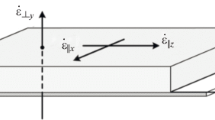Abstract
The main design aspects of two new, nearly complementary, planar reflection sensors for material moisture content measurement in the industrial environment are reported in this paper. The former is structured as a resonant microstrip ring interacting with the material under test (MUT) mainly through evanescent near fields, while the latter consists of a cavity-backed slot that couples to the MUT by radiative near fields. The sub-surface sensor-MUT interaction is numerically modeled in both cases by resorting to a full-wave electromagnetic (EM) approach based on the method of moments (MOM). If compared to the usual quasi-static approach, this method allows a more physical insight about the field-target coupling phenomena and a better accuracy in extracting the observable electrical parameters. A comparison between the two sensor types was made in order to address each sensor to its specific application field. In particular, the parametric sensitivity of both sensors to the most frequently recurring measuring artifacts was numerically analyzed. Finally, a prototype for each sensor type was constructed and experimentally tested in order to validate the results of the EM simulation.
Similar content being viewed by others
References
Brandelik, A. and Huebner, C., 2000, Subsurface sensing, subsurface aquametry: Int. J. Subsurface Sensing Technologies and Applications, v. 1, no. 4, p. 365-376.
Kraszewski, A.W., Nelson, S.O., and Yuo, T.S., 1990, Use of microwave resonant cavity for sensing dielectric properties of arbitrarily shaped biological objects: IEEE Transaction on Microwave Theory and Techniques, v. 38, no. 7, p. 858-863.
Olmi, R., Bini, M., Ignesti, A., and Riminesi, C., 2000, Non-destructive permittivity measurement of solid materials: Meas. Sci. Technol. v. 11, p. 1623-1629.
Fischer, M., Vainikainen, P., and Nifors, E., 1995, Design aspects of stripline resonator sensors for industrial applications: J. Microwave Power and Electromagnetic Energy, v. 30, no. 4, p. 246-257.
Sarabandi, K. and Li, E.S., 1997, Microstrip ring resonator for soil moisture measurements: IEEE Trans. on Geoscience and Remote Sensing, v. 35, no. 5, p. 1223-1231.
Joshi, K.R., Abegaoncar, M., Karecar, R.N., and Aiyer, R.C., 1997, Microstrip ring resonator as a moisture sensor for wheat grains: IEEE-MTT-S Digest, p. 1679-1682.
Yogi, R.A., Gangal, S.A., Aiyer, R.C., and Karekar, R.N., 1998, Microwave ring resonator as a novel bio-material moisture sensor: Sensor and Actuators, B50, p. 38-44.
Bramanti, M., 1991, A slot line microwave dielectric permittivity sensor for measure and control of laminated materials: J. Microwave Power and Electromagnetic Energy, v. 26, no. 2, p. 67-71.
Avitabile, G., Sottani, N., Salvador, C., and Gentili, B.G. 2001, Slot-coupled ring resonator for moisture measurement in an industrial environment: Electromagnetic Wave Interaction with Water and Moist Substances, May 13-16, Weimar, Germany.
Biffi Gentili, G., Riminesi, C., and Salvador, C., 2001, A new slot sensor for moisture content measurement of sheetlike materials: SPIE's Annual Meeting 2001 Symposium, July 21-28, San Diego, CA.
Weeler, H.A., 1977, Transmission line properties of a strip on a dielectric sheet on a plane: IEEE Trans. on Microwave Theory and Techniques, v. 25 no 8, p. 631-647.
Cohn, S.B., 1969, Slot line on a dielectric substrate: IEEE Trans. on Microwave Theory and Techniques, v. 47, no. 10, p. 768-778.
Gomez-Tagle, J. and Cristodoulou, C.G., 1997, Extended cavity model analysis of stacked microstrip ring antennas: IEEE Trans. on Antennas and Propagation, v. 45 no. 11, p. 1626-1635.
ENSEMBLE, 1997, Boulder Microwave Technologies, Inc.
Davison, D.B., Theron, I.P., Jakobus, U., Landstorfer, F.M., Meyer, F.J.C., Mostert, J.,and van Tonder, J.J., 1998, Recent progress on the antenna simulation program FEKO: COMSIG'98 (incorporating AP_MTT'98), Cape Town, p. 427-430.
Wang, J.R. and Schmugge, T.J., 1980, An empirical model for the complex dielectric permittivity of soils as a function of water content: IEEE Trans. on Geoscience and Remote Sensing, v. GE-18, no. 4, p. 288-295.
Meyer, W. and Schilz, W., 1981, Feasibility study of density-independent moisture measurement with microwave: IEEE Trans. on Microwave Theory and Techniques, v. 29, no. 7, p. 732-739.
Author information
Authors and Affiliations
Corresponding author
Rights and permissions
About this article
Cite this article
Biffi Gentili, G., Riminesi, C. & Sottani, N. Full-Wave Modeling of Microwave Planar Reflection Sensors for Material Moisture Testing. Subsurface Sensing Technologies and Applications 2, 453–470 (2001). https://doi.org/10.1023/A:1013277203441
Issue Date:
DOI: https://doi.org/10.1023/A:1013277203441




